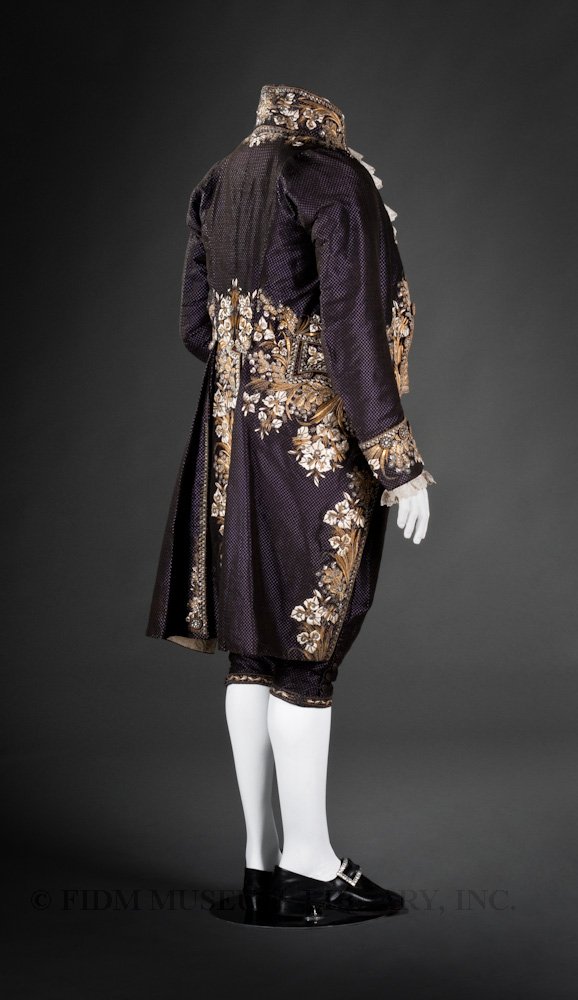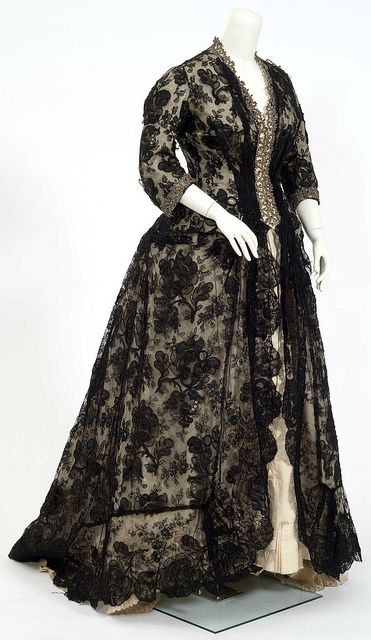The Historical Sew Fortnightly Challenge #9, due Thur 15 May, is Black and White. For this challenge you can make anything in black, or anything in white (and cream, ivory etc.), or (best of all) something in black and white.
I’ll let you find your own black or white inspiration (though my white inspiration post from last year might be a good starting point), and will just share a few of my favourite historical costumes in black and white.
This 14th century illustration shows a strikingly patterned gown in black and white on the far left (2nd from the left is pretty spectacular too!). There are other versions of the image that show the gown in gold and white, but as there are extent woodblock-printed fabrics from a similar period in black and white, it’s plausible that the gown might have been made up in black and white:
15th century Netherlandish artists such as Hans Memling made frequent use of the visual impact of black and white, as in this panel from a donor triptych:

Hans Memling. Triptych of Willem Moreel, donor portraits 1484, Öl auf Holz, 121 × 69 cm. Brügge, Groeningemuseum.
I am fascinated by Maria and her black, white and silver gown. How does it work? Is the black a separate robe fastened over a stiff bodice? Whatever is going on there, it’s certainly striking.
I’m not entirely certain if this court suit is black, but it certainly looks that way on my computer. In any case, how striking is the light embroidery on the extremely dark background? It’s all the grandeur and glamour of 18th century menswear, and all the elegance of Regency menswear.

Court suit worn by Johann Hummel, Uncut voided silk velvet, silk faille, silk embroidery floss, gold & silver embroidery purl & frieze, rhinestone & metal sequins c. 1810-14 Paris, France, FIDM Museum, 2008.947.2A-C
One of my favourite black and white combinations is for ball gowns, because it’s so unexpected. The following dress could be made up in any shade, but I do think black and white would be particularly effective:
And how beautiful is black lace over white fabric? Love this!:

Gown worn by Mahala Pillsbury, wife of John S. Pillsbury, to ceremonies marking her husband’s inauguration as the eighth governor of Minnesota in 1876, Minnesota Historical Society
There is some amazing black and white stuff to come out of the 1890s:
And, my favourite black & white item of all:
Oh swoon! I’m just waiting to find a pair worthy of turning in to these!
And the modernist approach in the 1920s also resulted in some beautiful black and white combinations, from graphic:
To sweet:









Black lace over white/cream/silver was one of my favorite ‘moments’ of the 90s. Looking forward to seeing what people come up with in an historical context!
Black and white is one of my favourite colour combinations. I have this vague idea that I might do black shoes with white embroidery, but we’ll see.
Now, I have a question about the Memling Triptych: those blacks do look very black. Was it really possible to achieve that shade of black with 1480s dyes?
A bit late but – yes! Absolutely! You can read a bit about dyes in the middle ages here:
http://books.google.com/books?id=CY-8T59wHHUC&pg=PA200&lpg=PA200&dq=black++dye+15th+century&source=bl&ots=KJtfpdAbQw&sig=jsV0Gl4ZF806887_KGzKdYB-D4c&hl=en&sa=X&ei=PHRcU5ieOMHisAS-0ILYBQ&ved=0CGMQ6AEwBg#v=onepage&q=black%20%20dye%2015th%20century&f=false
Also, there was always black sheep to give you black wool. 😉
I made a 14th century hood: http://galienneboivin.wordpress.com/2014/05/12/hsf-9-black-and-white/
I intended to make both a black and a white item, but only the white was a success; a 1930’s inspired hat:
http://levagabondage.blogspot.com/2014/05/challenge-nine-black-white.html
A 40’s blouse was my project for this challenge!
http://calicoclodhoppers.blogspot.com/2014/05/hsf-black-and-white-40s-seersucker.html
http://isabelladangelo.blogspot.com/2014/05/hsf-9-black-white.html
I created an Elizabethan Jacket. The pictures aren’t the best but they are up.
Bit late but my black and white 1940’s dress.
http://foggygardens.blogspot.com/2014/05/historical-fortnight-challenge-9-black.html
I completed a 1920s black and white plaid wool jumper with white blouse. The blouse I made last year, the dress was made for this challenge.
http://sewingfromanothertime.wordpress.com
Prentice
Delayed again.
http://amodernneedle.wordpress.com/2014/05/21/hsf-9-the-rose-red-wench-shirt/
http://wandabvictorian.wordpress.com/2014/05/12/hsf-14-challenge-9-black-and-white/
I never did share at the time but I had made a white with black polka dot WWII dress!
http://teacupsinthegarden.blogspot.com/2014/05/black-and-white-wwii-dress.html